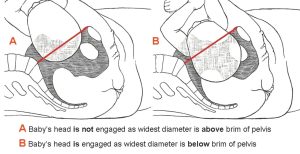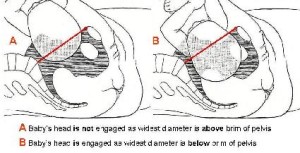What does engagement of my baby’s head mean?
Your baby’s head is engaged when the widest diameter of the head passes through the brim of your pelvis. A pregnant woman will often know this because of a very intense feeling of fullness in her pelvis. Some women have described it is a feeling like there is bowling ball in their pelvis. As well, she may have a feeling the baby “having dropped” (called “lightening”). She may be aware the height of the baby in her abdominal cavity is less, she may have less heartburn, etc.
Does baby’s head stay engaged?
Sometimes a baby’s head can be engaged one day and not the next.
Why does engagement happen?
As baby gets bigger there is less room in uterus and the abdominal cavity and so baby’s head is pushed down into the pelvis, to make more room.
In your second and subsequent pregnancy the uterus is often “looser” and doesn’t grip baby as tightly. So, your baby’s head often is not engaged before you are in labour.
Engagement all has to do with the relationship between the size and position of your baby’s head, the size and shape of your pelvis and how firm your uterus is and your uterus pushing your baby’s head into your pelvis in pregnancy.
When does engagement happen?
Engagement often happens in the first ongoing pregnancy from 36 weeks gestation. In subsequent pregnancies it often does not happen until you are in labour.
Does baby need to be engaged to go into labour?
No. Labour will happen irrespective of whether baby’s head is engaged. For your second and subsequent ongoing pregnancies it is common for baby’s head not to be engaged at the onset of labour.
What are the implications of baby’s head being engaged?
When baby’s head is engaged it puts pressure on the cervix. This stimulates the cervix. The cervix will often shorten and start to open before the onset of labour. You are more likely to go into labour sooner rather than later. But you can’t put a time on this. Sometimes baby’s head is engaged for weeks before the onset of labour.
Baby’s head being engaged also implies a quicker, more efficient labour and easier childbirth. It suggests baby is in a good position for childbirth, which we call occipito-anterior (baby has its back anterior).
What are the implications of baby’s head being engaged?
If it is your first ongoing pregnancy it suggests there could be a degree of cephalo-pelvic disproportion (baby’s head is too big for the pelvis). This could be due to the size of baby’s head, the size and/or shape of your pelvis, or baby’s head being deflexed (head not close to chest) and so a bigger diameter of baby’s head is presenting to the pelvis, or a combination of reasons. Baby’s head being deflexed is more likely if baby’s is an occipito-posterior position (baby’s front is facing your front).
Not being engaged means baby’s head is not applied to your cervix and so there is no stimulation for the cervix to shorten and open it before labour and no cervical stimulation for labour to start. It implies a greater likelihood of going overdue, having a longer and more difficult labour and childbirth experience.
In your second and subsequent ongoing pregnancies not to be engaged is common. It does not have same implications as in your first ongoing pregnancy. You still should have good labour and delivery as your uterus has a memory and is more efficient. The soft tissue resistance with pushing in your first delivery isn’t relevant. But baby’s head not being applied to your cervix means there is no stimulation for the cervix to shorten and open before labour and for labour to start. There is a greater likelihood of going overdue.
Can I do anything to make baby’s head engage?
No. There is nothing you can do.


